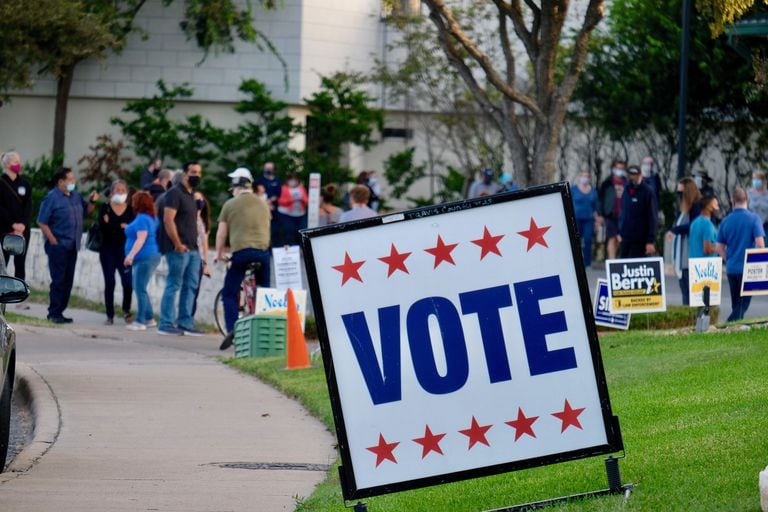An early voting point in Austin, Texas Illustrated Service (Automatic) / Europa Press
More than 99.5 million Americans have already voted early in historic elections.
This means that 73% of the votes registered in 2016 have already been cast before polling stations open across the country.
Still, a handful of states are key to the aspirations of Donald Trump and his rival, Democrat Joe Biden.
The re-election of the Republican or the victory of his opponent traverses a route of disputed territories.
Florida, Wisconsin, Pennsylvania, North Carolina, Ohio, and Georgia hold the key to success predicted by the 270 votes needed in the Electoral College to become president of the United States.
To these has been added, at the last minute, Texas, a typically republican region that has smashed participation records.
Florida has become a fierce scene of battle.
A Biden win would make things very uphill for Donald Trump's re-election.
An average Monday night poll puts the Democrat ahead by a slight advantage, 48% versus 46%.
If it is the Republican who prevails in the region of the swamps, this would put ice to an eventual Democratic victory, which would be obliged to secure other disputed territories.
This is a classic hinge state because its electorate is seduced by both Republicans and Democrats.
Trump won it surprisingly in 2016. Before that, Barack Obama won it in 2008 and 2012. Democrats have won 25 presidential elections there compared to 16 for Republicans.
It is a precious loot because it contributes 29 votes to the Electoral College.
It is the third state that contributes the most votes, equaled with New York, and surpassed only by California (55) and Texas (38).
Pennsylvania follows Florida in importance as a battlefield.
Historically, getting your 20 Electoral College votes was a relatively straightforward task for a Democratic candidate.
In the last seven elections, since 1992, it had been a blue state.
Except for 2016, when Donald Trump arrived and achieved one of his loudest victories of election night against Hillary Clinton.
Today things are tight between the candidates.
The polls put Biden slightly ahead of his home state by 2.5% (49.3% vs. 46.8%), but Trump focused many of his final efforts there to achieve what would be one of the surprises of the night.
The entity can mean the breaking point for either side.
The case of Wisconsin is similar to that of Pennsylvania.
His electorate had lived in the Democratic pocket until the working classes of this region of the Midwest found in Trump a figure to overturn their disenchantment.
Before the triumph of the former presenter of
The Apprentice, it
was necessary to go back to Ronald Reagan to find another Republican winner in the state, representing ten electoral votes.
In the last hours, Biden's advantage over Trump seems to have taken off and the state would be on track to make up for what it considers a mistake made four years ago.
Ohio (18), on the other hand, can give Trump joy on a difficult night.
The Democrat was a favorite there in September, but now the president is leading the polls and may repeat the achievement of 2016.
The Carolinas, North and South, and Georgia, represent territories where there will be high-voltage disputes.
The south has been a conservative region.
Things only look clear in South Carolina (9 electoral votes), which is inclined to give continuity to the Republican mandate.
In North Carolina (15 votes), Trump and Biden are in a technical tie, according to polls.
49% for Biden and 47% for Trump, according to CNN.
The traditionally Republican state was won by Trump in 2016. A Biden victory there is not unheard of.
In 2008, as a vice presidential candidate, he helped Barack Obama score the goal, when the Democrat beat John McCain by 0.3% of the total votes.
Going back to the blue would be a blow that would put Trump close to knockout on the night of 3-N.
Instead, Georgia (16), gives an oxygen balloon to the current president.
Although the polls also show a tie, the balance tips in favor of the Republican.
The battle for the border will be another that will have to be followed.
Arizona (11 votes) was a sure win for Biden in mid-September.
The gap has closed and today it is tied according to polls.
Four years ago Trump won there, but today a conservative alliance can turn its back on the president.
Texas deserves a special mention and its 38 electoral votes.
A few weeks ago, nobody looked at the second most populous state in the country because it was taken for granted that it would vote Republican, as it has done since 1980. Something has changed.
Analysts today consider it a state
toss up
, which is in the air.
A Democratic victory would be historic and the great surprise of the night, since it has not happened since the one that Jimmy Carter achieved.
It is unlikely.
Most polls favor Trump over Biden.
Four years ago the Republican had an eleven point advantage there.
Today is something more than one.
The last word will be for the Latino community.
The count
Those of this Tuesday will be a complex elections.
The high number of votes received before election day and the laws of each of the 50 states make it unpredictable to define the development of the night.
Florida, for example, has already started counting the more than nine million early votes received, representing 95% of the total votes in 2016. The same is true in Arizona, North Carolina, and large Michigan cities.
There are other regions that will not begin counting early votes until polling stations close, between 7:00 p.m. and 8:00 p.m. in most states, or even after counting those cast on November 3.
The decisive Wisconsin and Pennsylvania are among these.
This complicates an early victory for Biden, unless the Democrat achieves decisive victories in Florida or Texas.
Four years ago, the lace came from 80,000 votes in Pennsylvania, Wisconsin and Michigan.
The data was released then fairly quickly, but this year everything will be different due to the number of votes.
Almost half of the states have said that postal ballots that arrive after Election Day will be valid as long as the stamp indicates it was sent before November 3.
This can further delay the results.
For example, North Carolina (15 votes), one of the most contested states, will have 80% scrutinized shortly after schools close.
The victories should be wide enough that you don't have to wait for the last vote to count.
Four years ago, Clinton acknowledged his defeat at around 2:30 a.m. Washington.
An hour before she was clearly considered the loser.
This year a rejection of the results by Trump could delay the victory ritual and throw more confusion over the process.






/cloudfront-eu-central-1.images.arcpublishing.com/prisa/2C5HI6YHNFHDLJSBNWHOIAS2AE.jpeg)



